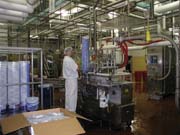
An estimated 11 million Americans have food allergies, including 4-8% of children and 1-2% of adults. Food allergic reactions are estimated to cause 29,000 emergency room visits and 150-200 deaths per year. No processor wants their product to be included in these statistics. An understanding of the foods that cause allergic reactions, controls that can reduce risk, and tools that can verify adequate control can reduce the risk that dairy processors face when they produce products that contain a variety of allergens.
Defining food allergies
A true food allergy is a response in which the body's immune system overreacts to protein in the food. This should not be confused with food intolerance, such as lactose intolerance, that involves an enzyme deficiency or other non-immune cause. Allergic reactions can involve skin (hives), gastrointestinal (nausea, cramps, diarrhea), respiratory (struggle for air), and circulatory (blood pressure drop) symptoms. In extreme cases, anaphylaxis can occur in which multiple organ systems are triggered and death can occur in minutes.
All food allergens are naturally-occurring proteins that are very resistant to heat, proteolysis, and pH. Trace amounts at parts per million levels can cause a reaction. Sensitivity and severity of reactions varies by individual and amount of the allergenic material present. Avoidance of the allergen is the only thing that an allergic individual can do to prevent a reaction.

foods including milk itself and common ice cream ingredients like nuts.
In the spotlight
Food allergy has existed for many years. Several groundbreaking reports published in the late 1980s and early 1990s heightened awareness of the food allergy issue and product recalls began. The trend toward value-added products and the diversity of products in the market place has increased the combinations of ingredients used in products and this complicates allergen management for processors, thus the potential allergen exposure has increased.
While the percentage of individuals with diagnosed food allergies is relatively small, those that think they have food allergies or purchase products for allergic individuals has been estimated to be as much as 30% of the population. These people are very brand loyal and purchase brands that they have consumed safely in the past.
The Big Eight
Eight foods are responsible for over 90% of all food allergic reactions. These are peanuts, tree nuts (such as cashews, almonds, walnuts, etc.), milk, egg, soy, fish, shellfish (crustacean), and wheat. There are over 160 foods that can also cause allergic reactions, but the focus for control and regulatory action are on the so-called Big Eight because controlling these will control the most prevalent and severe reactions. Soy, milk, egg and wheat allergy tend to be issues for children and they generally out grow their sensitivity to these foods. Allergy to crustaceans (shrimp, crab, lobster, etc.) and fish generally develop in adults, while peanut and tree nut allergy impacts both children and adults and persists throughout life.
Highly refined products derived from some of the Big Eight allergens may have the allergenic proteins removed. For example, highly refined soy bean oil has not been shown to demonstrate allergic reactions.

Controlling allergens
There are three basic control strategies for food allergens: 1) dedication, 2) separation, and 3) labeling. For dairy operations that process only milk and milk products, dedication is the answer. Milk is clearly labeled and those individuals with a milk allergy will avoid the product. However, the situation is not so simple for operations that produce products in addition to milk. When soy beverages or juice products are added to a fluid milk production schedule, allergens become a concern. Management issues are even more complex with products such as ice cream that may have nuts and particulates with allergens. Each type of nut can have different allergenic proteins so they must be treated as separate and distinct allergens. Filtering or screening these out of fluid mix does not remove all of the allergenic proteins that may elicit an allergic reaction.When processing products that contain different allergenic ingredients, a plan is essential. A comprehensive Allergen Prevention Plan includes allergen mapping, ingredient control, system design, traffic patterns, work-in-process, maintenance, packaging and labeling, scheduling, effective cleaning, and training.
Allergen mapping: It is important to understand where allergens are in the plant and where they are introduced into the process. When the primary product is a food allergen, it will obviously be present throughout the facility. However, some products, such as ice cream, add ingredients at various stages throughout the process. Mapping where these additions are made can be very informative in determining where the potential for allergen cross contact becomes a concern and where control is needed. For example, particulates may be added to ice cream before or after the freezer. Addition after the freezer, if possible, can remove the potential for particulates to become trapped in freezer blades.
Ingredient control: Every processor should obtain detailed information from suppliers on all of the components that go into their ingredients to ensure that allergens are properly identified. It is also important to evaluate how suppliers control allergens. For example, it would be prudent to ensure that a nut supplier does not roast different kinds of nuts in the same oil, which could lead to cross contact of allergens.
System design: The same sanitary design principles that apply for microbiological control apply to allergen control. All equipment must be designed for ease of cleaning, with access for cleanouts and inspection to ensure that the job is being done properly. Equipment design should not allow accumulation dead spots that can later break off during subsequent processing. As mentioned under allergen mapping, addition of allergens later in the process can be very useful in minimizing the potential cross contact. For particularly difficult to clean equipment, it is useful to have parallel modules with one dedicated to allergenic ingredients. Consideration should also be given to dedicated recoup or re-feed systems to ensure that cross contact does not occur.
Traffic patterns: One element of traffic patterns is related to system design, that is, production line crossovers. Many dairy processing systems are closed, which minimizes the potential for product to unintentionally drop into product on an open conveyor, vat, or holding tank. However, a careful review of the pattern that allergenic products, ingredients, and the people that work with them take in the plant must be done to evaluate the potential for this to occur.
Work-in-process and rework: All work-in-process and rework must be clearly labeled to identify those that contain allergens. Color coded containers or labels have been a useful tool. Instructions on the use of rework should be posted on containers and /or with operator instructions to ensure that it is properly used. It is recommended that rework containing unique allergens should be used only in the same formulation, that is "exact into exact". A periodic audit of rework practices is advisable to ensure continued application of effective allergen control practices.
Maintenance: Ongoing maintenance of all equipment is essential to ensure that the system is operating as designed and that product hang up points do not develop. Because of this, it is important to include maintenance personnel in allergen system design and training to ensure that they are aware of the risks and, most importantly, to use their experience in identifying and designing effective controls for the issues that they have observed.
Packaging and labeling: Labeling is the primary control tool that a consumer uses to avoid consumption of a food allergen. Because of this, it is essential that the information on the label accurately identifies allergens that are present in the product. New allergen labeling regulations become effective on January 1, 2006. Effective control of labels requires a thorough review of all components in ingredients as described above, and allergens must be properly identified on the label. It is also important to review the labels upon receipt from the printer to check for printing errors. Finally, the label must be applied to the right product.
Scheduling: Dedicated production systems can reduce the need to evaluate scheduling as a means to control for allergens. Unfortunately, dedicated systems are not economically feasible for many operations. Longer production runs minimize the number of change-overs, and thus the potential for allergen concerns. Allergen containing products should be run at the end of the production sequence. The cut off between product runs must be clearly defined to avoid the possibility of allergens to be present in unlabeled product. Allow time for a thorough clean out between runs to avoid cross contact.
Cleaning: Time requirements for cleaning to remove allergens depend on the complexity of the system and the type of soil. When evaluating the effectiveness of cleaning procedures for allergen control, it is important to focus on the result and not merely the process itself. In other words, it is essential to validate that the procedures used actually removed the allergens. Disassemble and manually clean all equipment that cannot be cleaned thoroughly in place. Accessory tools or equipment such as scoops, pails, totes, bins, hoppers, etc. need to be cleaned as well. Use of dedicated, color coded accessory equipment can add an extra margin of safety for allergen control. Cleaning implements should also be considered as a potential source of allergen cross over. Evaluate these tools to ensure that they are doing the job that they are intended to do.
Training: Training is the key to sustaining an effective allergen control program. The basics of allergens should be covered to ensure that all employees understand the real health consequences that can result when products are not properly labeled. Operations, research and development, maintenance, and others should be included in the training efforts. Some facilities have used certification teams as a motivational factor in allergen control. Videos are available from organizations such as the Food Allergy Research and Resource Program (www.farrp.org) to assist with plant training efforts.

Validating your cleaning
The first step in validating the effectiveness of cleaning is to visually inspect the cleaned equipment. Inspect all parts of the system, including breaking it down to parts that are not typically accessed. Benchmark what it takes to achieve an allergen free system. Any sign of visual residue indicates that cleaning is not sufficient to remove allergens. Once visual cleaning can be achieved on a reliable basis using sanitation standard operating procedures (SSOP), allergen specific tests provide additional validation to demonstrate that allergenic proteins are removed when the SSOP is followed. Typically, these are not run routinely because of expense, time requirements, and complexity of running the test. General ATP tests, which are popular for verification of cleaning procedures, may not have the required sensitivity to provide ongoing verification of adequate allergen cleaning. However, tests such as Allergiene™, a highly sensitive non-specific ATP test, may be used in parallel with allergen specific testing to validate the process, and then used routinely to provide ongoing verification that cleaning procedures are conducted as designed. The test detects microbial ATP as well ATP associated with residual food and is only applicable in wet cleaning systems where all ATP is removed. Ecolab is supporting research in this area to continue to provide tools that can be used for effective allergen controls.
The need for effective allergen control is an ongoing concern. As consumers demand more variety in their products, the challenges faced by processors increase. However, careful planning and attention to superior cleaning and verification tools can control the issue. Ecolab's expertise in cleaning solutions can assist with allergen control programs.
The Big Eight Allergens
- Peanuts
- Tree nuts (almonds, cashews, walnuts, hazelnuts, etc.)
- Milk
- Egg
- Soy
- Fish
- Shellfish (lobster, crab, crawfish, etc.)
- Wheat
Sidebar: IDFA Continues to Champion HACCP for Dairies
Since the early 1990s the International Dairy Foods Assn. has been a proponent of HACCP (Hazard Analysis and Critical Control Point) as a tool for fighting microbial and other contamination in dairy processing plants. The organization has also worked diligently to provide HACCP training for the industry.In 1999 the organization launched a pilot program offering HACCP certification for dairy processors. Through that program, and interest from processors outside the program, nearly a dozen processors have achieved certification in dairy or juice HAACP. IDFA publishes a HACCP manual and continues to develop educational material and to present training for dairy processors who choose to use HACCP.
Those efforts continue in 2005, says Allen Sayler, dir. of regulatory affairs and international standards at IDFA.
"We found that not everyone who is interested in HACCP needs the certification, so we are now introducing a non-certification program that results in an evaluation and report that the processor can have for its own purposes," Sayler said.
IDFA will continue to offer certification programs as well. This may be of particular interest to dairies that produce 100% juice products, as FDA now requires HACCP certification for juice processors. Sayler notes that dairies account for nearly 30% of all the fresh refrigerated juice bottled in the United States.
Sayler recognizes that processors using HACCP have had some difficulties with FDA and state inspections. He says he is hopeful that the agency will eventually be able to bring field inspectors up to speed on something that they have not had a great deal of exposure to.
In fact, the National Conference on Interstate Milk Shipments (NCIMS) will hold a training program for state inspectors next month. Meanwhile IDFA's next HACCP Workshop is scheduled for February 22-24 in Washington D.C.
For more information contact Sayler at 202/737-4332 or visit www.idfa.org.
